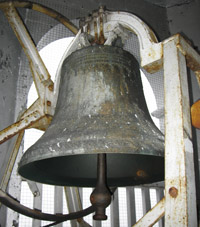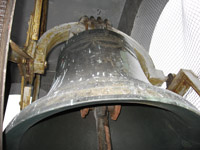Voice of God and inimitable quartet
 Like countless others throughout the western world, St. Anne Church possesses a ring of bells and is lucky enough to be able to boast of a particularly fine set that give the 140 year old building its very own, special and unique “voice”. Over the years that voice has called out to summon the faithful to prayer, accompanied them during moments marking life’s joyful occasions such as weddings or significant feasts of the liturgical calendar and the welcoming of high-ranking visitors, given voice to their sorrow at funerals and been missed by the community at large when, for a long period they fell silent. When the bells of St. Anne Church on Old St. Patrick Street in Ottawa’s Lower Town rang out for the first time in two years in celebration of the Resurrection on Easter Sunday 2013, their sound brought all the parishioners outside into the pale sunshine of a chilly March morning to better hear them, moved many to tears and warranted the presence of TV news cameras.
Like countless others throughout the western world, St. Anne Church possesses a ring of bells and is lucky enough to be able to boast of a particularly fine set that give the 140 year old building its very own, special and unique “voice”. Over the years that voice has called out to summon the faithful to prayer, accompanied them during moments marking life’s joyful occasions such as weddings or significant feasts of the liturgical calendar and the welcoming of high-ranking visitors, given voice to their sorrow at funerals and been missed by the community at large when, for a long period they fell silent. When the bells of St. Anne Church on Old St. Patrick Street in Ottawa’s Lower Town rang out for the first time in two years in celebration of the Resurrection on Easter Sunday 2013, their sound brought all the parishioners outside into the pale sunshine of a chilly March morning to better hear them, moved many to tears and warranted the presence of TV news cameras.
Bells have been associated with religious observance throughout much of the world since antiquity and with the Church since very early in its history. Their use would seem to have been first spread across northern Europe by the Irish after their conversion to Christianity in the fifth century and subsequently adopted by the Church at large. In Rome, the Liber Pontificalis tells us that during his pontificate Pope Stephen II (752-757) for example, erected a belfry with three bells (campagnae) at St. Peters.[1] Over time, bells came to be regarded as an essential attribute of every church assuming a place and significance in the rhythm of the life of the Church’s religious observances and that of its surrounding communities that has continued uninterrupted to the present day. Additionally, throughout the ages, church bells have also always had a significance that goes beyond their strict liturgical role and are the source of civic pride for communities lucky enough to possess special ones, receiving names and becoming closely linked to communal identity. This is because bells speak to the community as well as to the individual. People have always known their bells intimately, recognized their unique sound, given them names and taken care to have “baptized” those intended for the church before hanging them in a tower especially built to receive them. That a bell is felt to “speak” is borne out by the widespread custom of its inscriptions which are most often in the first person, as if the bell were actually speaking the words inscribed upon it.

The four bells of St. Anne were born out of and continue these traditions. Dating from the beginning of the 20th century, they were purchased in 1910 from the prestigious French foundry Paccard [2] established in 1796 and still in existence today. The bells fell silent when their church closed in 2011 and initially remained so a year later in 2012 when the church was offered to St. Clement Parish by His Grace Archbishop Terrence Prendergast,s.j..[3] Silent and then feared inoperative when a crack was discovered in one of the supporting beams of the bell tower, it was not until Easter 2013 that the Lower Town community was able to hear its bells ring out once more. There is something very fitting in the bells of St. Anne returning to use in time to celebrate the Resurrection. There were in effect three reasons to celebrate that Easter morning – the Resurrection of our Lord, the rebirth in its 140th anniversary year of a patrimonial church come very close to definitive closure and with the completion of engineering repairs to the tower, the return to God’s service of the bells.
A bell is cast using a mold into which is poured a molten alloy of 78% copper and 22% tin that is known as bronze and after is tuned by filing to give it its very own special sound, a “voice” like no other. Cast in Haute Savoie in France in accordance with a craft that has remained essentially unchanged since the 12th century and that involves a mold of stone or brick covered with sand or loam sometimes mixed with horse manure,[4] the four bells of St. Anne weigh close to 4 000 lbs. Each one of them carries its own emblem and dedicatory inscription. The first and largest bell weighs 1 500lbs and has a strike note of G; the second weighs 1 100lbs and has a strike note of A; the third at 800lbs has a strike note of B and finally, the fourth and smallest one weighing 500lbs, has a strike note of D.

As is fitting for bells born of tradition, the inscriptions carried by those of St. Anne tell us a great deal about the times during which they were cast and the community that came together to make a very expensive purchase in the name of their parish church. Like all parishioners of the time, the people who purchased them did so out of deeply held convictions. “Their collective identity was linked to their church, as though it was a symbol, or, more precisely, the incarnation of what otherwise could not have substance.”[5] All four bells are struck with dedications that reflect their community and carry quotations from Scripture that the bell is said to “speak” when it is rung. The first and largest carries the coat of arms of His Holiness Pope Pius X as well as those of Canada along with the Latin inscription “Vox exultationis et Salutis in tabernaculis justorum/The voice of Joy and Salvation in the temple of the just”. The second is engraved with the emblems of the Sacred Heart of Jesus, the Adoration of the Blessed Sacrament and the citation “Adveniat Regum Tuum; J.O. Routhier,administrateur Sede Vacante 1910/Thy Kingdom Come; J.O. Routhier,administrator Sede Vacante 1910”. The third bell carries the emblem of the Immaculate Conception, the Sacred Heart of Mary and the inscription “Dexetera Domini fecit virtutem dextera, Domini exaltavit me/The right hand of the Lord has rendered me virtuous, it has exalted me”. The fourth and smallest of the set is engraved with the emblems of the Good Shepherd and St. Joseph and carries the inscription “Tu autem Domine Gloria mea exaltans Caput meum” and “Joseph Alfred Myrand, curé de la paroisse 1910/And my soul, O Lord, shall sing of your glory” and “Joseph Alfred Myrand, Parish priest, 1910”.
If we know something about the bells of St. Anne and the traditions that gave them birth they have none the less managed to keep secret part of their story. We do not know, for example, how much they cost the parish who commissioned them from Paccard’s Montreal–based representative, Mr. Z. Adessa Tourangeau.[6] A fire in 1920 that destroyed many church records[7] means that the bells in all likelihood will continue to keep this secret to themselves. What we can be confident of is that they represented a significant financial sacrifice on behalf of a working class parish, especially in the light of the fact that the average annual salary for a unionized labourer at the time was $405.[8] While we do not know their cost, we do know something about their original operation and the outlay it required. Ever since their installation in the bell tower, St. Anne’s bells have been set ringing by means of an electrical device. The original mechanism used to ring the bells was purchased in Montreal at a cost of $1 245.[9] That amount was almost totally covered by a special collection of just over $1 000 the day of the benediction of the bells on Sunday, December 4, 1910, a gesture of unquestionable generosity. It is this spirit of generosity that allowed the bells of St. Anne to take their place in the time-honoured tradition of service to God.
Although today sometimes viewed as nothing more than a quaint, decorative adjunct of the Church by many and even occasionally by others as irksome reminders of the divine in a secular world, church bells perform the particular task of signal importance that they have always performed. Their work, in addition to often serving to mark the passing of the hours has always had a religious vocation at its core and, when struck in God’s honour, recall the holy to the minds of the faithful.
© St. Clement Parish at St. Anne Church 2013
[1] H. Thurston, “Bells”, The Catholic Encyclopedia, accessed May 29, 2013, http://www.newadvent.org/cathen/02418b.htm
[2] Jules Tremblay, Sainte-Anne d’Ottawa – Un résumé d’histoire 1873 -1973 (Ottawa, 1925), 253
[3] Archdiocese of Ottawa, Archbishop Prendergast welcomes the move of St. Clement Parish to Ste-Anne Church, 23 April, 2012
[4] “Bellfounding”, Wikipedia, last modified 28 February 2013, http://en.wikipedia.org/wiki/Bellfounding
[5] François Mathieu, Les cloches d’Égilse du Québec – Sujets de culture (Québec, 2010), 173
[6] Le Temps, 5 December 1910, “Bénédiction de cloches à l’Église Sainte-Anne”, 5 Dec. 1910, 8
[7] Jules Tremblay, Sainte-Anne d’Ottawa, v
[8] Canada Department of Labour, The Labour Gazette, July 1907- June 1908 (Ottawa, 1908)
[9] Jules Tremblay, Sainte-Anne d’Ottawa, 254
